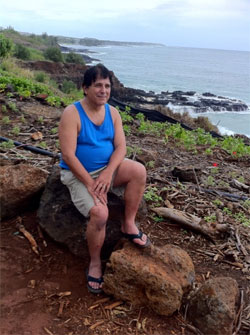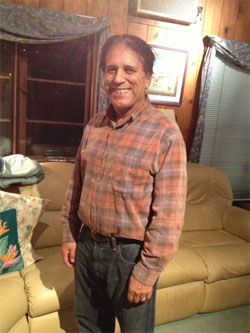A few months ago, I found myself asking the question that so many of my students and colleagues were polite enough to not ask me:
“What is an herbalist, author of multiple best-selling books and articles on natural healing, mentor to an entire generation of healers, doing walking around with a pot belly and some 40 to 50 pounds of life-threatening flab?
The truth is, I had tried on numerous occasions to lose weight using various well known methods, including fasting. Fasting certainly works as any caloric reduction would, but the problem is the almost uncontrollable urge to eat anything and everything, especially after completion of a fast. It’s the old ‘action-reaction’ law that haunts everything we try to do.
Basically, whatever one has to say about weight loss, and evidently judging from the plethora of books and experts out there, that’s a lot, it all boils down to caloric restriction and raising one’s metabolism; in other words, less food and more movement.
But there is one more vitally important aspect to weight loss, one that has been the unique aspect of the Weight Watchers method: the psycho-emotional component. It was in September 1961 that Jean Nidetch, an overweight woman from Queens, NY, called a group of friends to share her obsession of eating freshly baked cookies. It was from this that she realized that the most effective keys to weight control was not only the types and amount of foods that one eats but the mental aspects of “empathy, rapport and mutual understanding” that precedes all other measures. Her discovery resulted in a personal 70-pound weight loss and the beginning of one of the most effective weight control organizations in the world. Jean began by turning her weekly cookie eating fests to weekly support gatherings to encourage and help fellow dieters to lose weight and feel healthier. The key was gentle and supportive, personal and collective accountability. With that philosophy at its core, Weight Watchers was organized as a company in 1963. Instead of counting calories that went into the thousands each day they developed a system of counting only a limited number of points – an important psychological approach that makes the whole thing a lot more practical than counting calories.
Depending on one’s starting weight a fixed number of points is allotted for each day. In order to keep weight loss balanced, and to prevent rebound so that the loss is permanent, the number of points allotted for each day during the weight loss phase continues to slightly diminish as one loses weight. Because many consider Weight Watchers not simply a weight loss method but weight maintenance one as well, when one reaches one’s target weight range, the formula changes to allow more points for weight management. It is at that stage that one can solicit Weight Watchers for free lifetime membership.
Previous to Weight Watchers, I would start a diet program and then find that I was getting nowhere because I always managed to eat more than I needed since I didn’t realize how much that extra slice of bread or ice cream indulgence really cost me in terms of my ability to lose weight. So I failed and gave up.
Next there were the restrictive diet regimes, many if not all of which I know intimately and well, either from personal experience or the countless numbers of patients I’ve supervised over decades. Such programs definitely work for awhile but again the pendulum swings back and before we know it we have driven ourselves insane following some rigid fad dietary regime that denies us access to our favorite foods. This drives to the other end of dietary insanity, where we find ourselves putting on the pounds with beer, pasta, cake, pies, candy, you name it.
Weight Watchers’ success is in the realization that strictly in terms of weight loss, along with food quantity, it is not so much what we eat but how much accountability we keep to others and ourselves.
The funny thing is, I knew that Weight Watchers worked because I tried it several years ago and had indeed lost weight. The problem then was that it was inconvenient to keep a handwritten daily diet diary and making sure that I ate within the personally allotted daily point allowance based on my weight. Nowadays, they still have personal calculator that one can purchase to be sure one stays within the daily allowance, but I personally found that downloading and using the Weight Watchers online app for iPhone (and other smart phones), together with the handy bar scanner where one could scan a product’s bar code to get the number of points for a serving of any packaged food makes the process of weight loss like a game based on the choices I make and am willing to make throughout the day.
Rather than ruling out an indulgence of that wonderful aroma of baked flour, fat, sugar and cinnamon that wafts to my senses between flights in airports, I can look up the points for the Cinnabon and see that yes, I could eat it, but it will cost me an entire day’s worth of 30 points to do so, and isn’t really worth it.
In addition to knowing how many points I am allowed to consume and the convenience of logging these on my iPhone app, what makes Weight Watchers really work for me is going to the weekly weigh-in sessions, which take about 45 minutes each week. So far as I’m concerned, all three components have been an essential part of my commitment.
One of the common complaints about Weight Watchers has been that previously it did not emphasize healthy eating as much. Attempting to maintain its fundamental approach that allows one to eat or drink anything so long as they remain within the point allowance, in recent years Weight Watchers evolved a Points Plus system. This identifies a category of pure, nutrient dense, whole foods in a recommended category of “Power Foods.” Consuming more of these foods leads to greater satisfaction, less hunger and greater health. For example, a cup of rice, whether it is white or brown, is still 5 points. Since it is always about making smart choices, one may choose whether a half cup at approximately 2 points or so together with a high protein food such as an egg, also at 2 points, would be a better and more long lasting satisfying choice. Weight Watchers also allows a limitless amount of vegetables and within reason fresh fruit point-free and they encourage five servings of these daily which goes a long way toward feeling satisfied while losing weight. Because many mistake the need for food with the need for water, Weight Watchers recommends 8 to 10 glasses of water daily. I don’t think this takes into account the increased tendency towards frequent urination that occurs for many as they age.
Often when I counsel patients on diet I ask them to keep a diet diary. Each time they bring it to me I tell them how their food choices may sabotage their efforts to heal. I then began to consider that what was good for the goose just might be good for the gander (me). Serendipitously, this occurred just at the time when I read a study published in the August 2012 edition of the American Journal of Preventive Medicine1. It was a sizable study involving 1,685 overweight or obese U.S. adults ranging from 25 years and older that found that people who kept food diaries and were only encouraged to eat a healthy diet and keep physically active were able to shed almost 13 pounds on average. According to the senior investigator, Victor Stevens, PhD, senior investigator at the Kaiser Permanente Center for Health Research in Portland, Ore., “those who kept food records six days a week — jotting down everything they ate and drank on those days — lost about twice as much weight as those who kept food records one day a week or less.”
Much like Weight Watchers, accountability, rather than whether someone ate too much sugar or not enough whole grains or vegetables, was the major reason for the success of this approach to weight loss. This was further emphasized by the fact that these subjects were also required to meet weekly in groups to share their food diaries and brush up on skills like how to judge portion size.
Somehow this rang a bell for me and it didn’t take long for me to reconsider Weight Watchers, the only systematic approach to weight loss that I had tried and achieved a measure of success.
As an Italian, my dietary Achilles’ heel is pasta. On New Year’s eve, Lesley and I went to dinner at our favorite newly opened local Italian restaurant (for those of you who live in the Santa Cruz area it’s called Casa Nostra and it happens to be located in my hometown of Ben Lomond). Knowing that we were going to dinner that evening, I had only one meal that day: an 8-point breakfast of whole grain cereal, banana, blueberries, lycii berries, walnuts (the best appetite appeaser), and non-fat milk. This left me with 27 points for the evening, enough to accommodate an uncharacteristic indulgence in a superb marinara meat lasagna. It so happened that theirs was not so much smothered with high calorie cheese but with beef so to my taste the consistency, the health value and the points were better. If I didn’t have so many points to spend, I would have had to consider halving the serving for a meal the next day, instead, I was happy to indulge my epicurean propensity and eat their full portion. When I tabulated the points I found that of even this at best only took up perhaps 12 to 14 of my 27 points remaining. This left room for our stopping after a movie at another excellent local German restaurant (Tyrolean Inn) for their most exquisite warm apple strudel even topped with a dollop of whipped cream!
The next morning I awoke, meditated, got to the bathroom scale, and was delighted to learn that I didn’t gain weight from my on-the-town foray of the previous night. In fact, I even lost a tad. This was even before getting on the elliptical rider, which I alternate with a daily two-mile jog and some weight resistance training and yoga. Besides the self-esteem that many associate with a thinner body, there is the real benefit of the ability to enjoy life more fully. One of my greatest satisfactions is that I can now do all the yoga asanas I once used to do some 20 or so years ago.
And oh, I forgot to tell you how much weight I have lost over five-month period – a whopping 30 pounds! At the young age of 73, I’m rapidly approaching my new weight goal, which may be close to what I was in my late teens. By the way, about four months ago I gifted one of my grown children a Weight Watchers membership and she just let me know that she’s lost 19 pounds to date.


Above: Michael Tierra before (left), and after (right) Weight Watchers
So if you are into making another New Year’s resolution to shed the pounds, I suggest that you consider joining Weight Watchers online and attend the local weekly meetings for at least the first three months. I think the further accountability and the ongoing support from others who are on the same path is well worth the modest expense.
So there you have it! I’ve given you all my new year’s advice for the big question that many have at this time – how to lose weight in this year. May you be as successful and feel as good.
[i] American Journal of Preventive Medicine Volume 35, Issue 2, Pages 118-126 (August 2008) DOI:10.1016/j.amepre.2008.04.013

